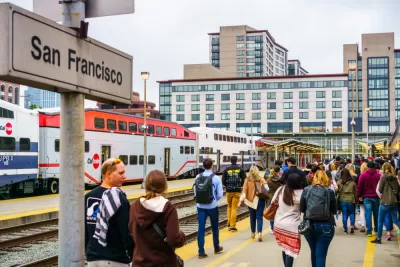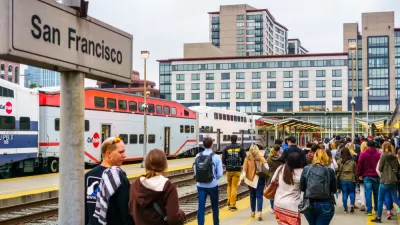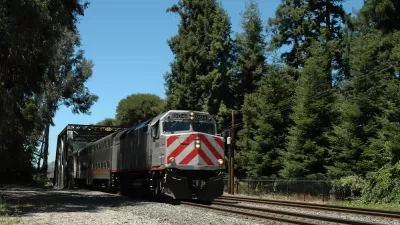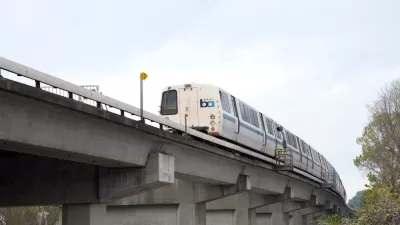A plan to integrate the various regional transit providers in the San Francisco Bay Area could be the key to winning back transit riders in the post-pandemic world.

Momentum is building for an idea that would merge Bay Area Rapid Transit (BART) with CalTrain and other regional rail providers to create a single regional rail system that would completely encircle the San Francisco Bay Area, reports Nico Savidge.
Seamless Bay Area released a report earlier this month that "recommends bringing BART, Caltrain and other longer-distance operators such as San Francisco Bay Ferry and the North Bay's Golden Gate Transit together into a single system that stretches from Santa Rosa to Gilroy," according to Savidge.
The report recommends an integrated fare system that would create a zone system for fares—charging one price even if riders transfer from one system to another within a zone.
"It's a long-debated idea, but there are signs momentum could be building," writes Savidge. "A merger with BART is one of the concepts Caltrain's board is considering this year as it overhauls the railroad's management. And COVID-19 has upped the pressure throughout the Bay Area to better coordinate service between agencies if they want to win back riders in the post-pandemic world."
Savidge provides more evidence of the growing political momentum for the idea in the source article (which is also available at Mass Transit if The Mercury News paywall is an obstacle). One key driver of the new momentum for the idea of integrated regional rail in the Bay Area is the need to entice riders back to transit in the post-pandemic world.
Meanwhile, Seamless Bay Area has launched a Kickstarter to raise the funds to create a board game called Connect the Bay to illustrate the integrated fare concept.
FULL STORY: Could a BART-Caltrain merger help fix one of Bay Area transit's biggest problems?

Alabama: Trump Terminates Settlements for Black Communities Harmed By Raw Sewage
Trump deemed the landmark civil rights agreement “illegal DEI and environmental justice policy.”

Planetizen Federal Action Tracker
A weekly monitor of how Trump’s orders and actions are impacting planners and planning in America.

The 120 Year Old Tiny Home Villages That Sheltered San Francisco’s Earthquake Refugees
More than a century ago, San Francisco mobilized to house thousands of residents displaced by the 1906 earthquake. Could their strategy offer a model for the present?

Ken Jennings Launches Transit Web Series
The Jeopardy champ wants you to ride public transit.

BLM To Rescind Public Lands Rule
The change will downgrade conservation, once again putting federal land at risk for mining and other extractive uses.

Indy Neighborhood Group Builds Temporary Multi-Use Path
Community members, aided in part by funding from the city, repurposed a vehicle lane to create a protected bike and pedestrian path for the summer season.
Urban Design for Planners 1: Software Tools
This six-course series explores essential urban design concepts using open source software and equips planners with the tools they need to participate fully in the urban design process.
Planning for Universal Design
Learn the tools for implementing Universal Design in planning regulations.
Clanton & Associates, Inc.
Jessamine County Fiscal Court
Institute for Housing and Urban Development Studies (IHS)
City of Grandview
Harvard GSD Executive Education
Toledo-Lucas County Plan Commissions
Salt Lake City
NYU Wagner Graduate School of Public Service





























